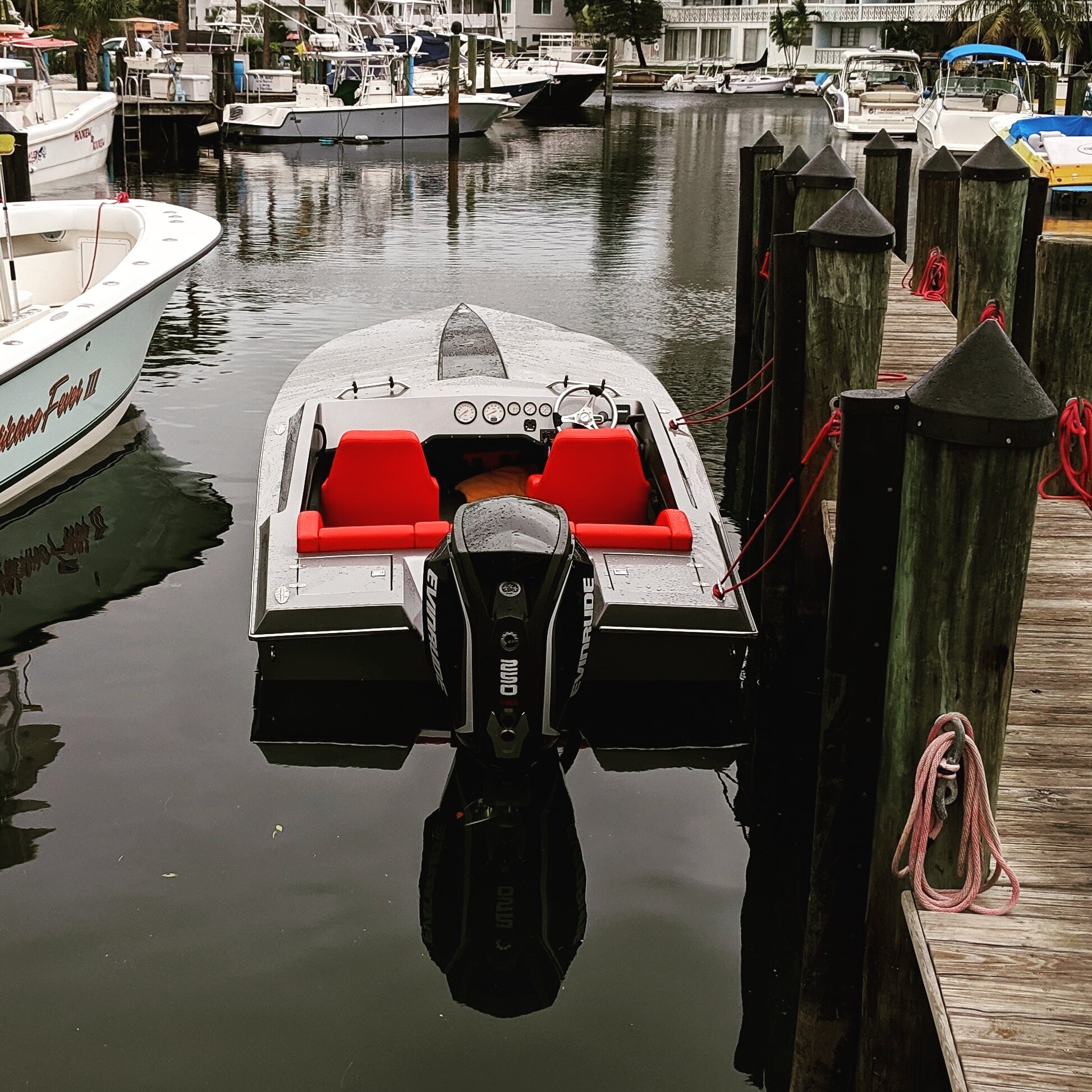Big Outboards: Going Overboard on Horsepower
It’s hard not to notice the proliferation of more power being added to transoms on boats of all kinds. Any true boat enthusiast knows that power is just one component of a performance boat and it’s not the most important at all. There is a “right” amount of power for many boats. Boats are not like cars, which can also be overpowered, but in boats it is more delicate because the hull itself has to be capable of utilizing the extra power safety wise and dynamically; there is a point of diminishing returns. When it comes to smaller boats, the safety factor is more imminent. My argument is get an engine that is the appropriate power and weight, then focus on the setup to get it running as efficiently as possible. Overpowering your boat is not safe, not efficient and often has really bad results.
Recently, I have learned of a few cases of smaller boats having accidents that were directly related to being overpowered. I say directly related because often it is the weight of the engine that can be the culprit and not necessarily the power at the prop or speed, although they both can negatively contribute. Heavy engines can cause issues when the boat starts to get loose, or a little out of shape. That heavy engine can be like a pendulum and exacerbate any handling issues like chine walking or when the boat is thrown into a tight high speed turn. That said, there are some small boats that are indeed designed to go very fast and can accommodate modern power.
Today, there are some great options for smaller boats, like the 115 and 150 ProXS. On smaller boats, there is a law of diminishing returns where adding power becomes less and less efficient. Power up to what your boat is designed for.
Generally speaking, the average 150 HP outboard today, is about 60 Lbs heavier than 12 years ago, while the average 200 is even greater than that at about 100 Lbs heavier. Modern 200s have more torque, more power and are more efficient and the extra weight has a lot to do with most manufacturers moving their 200 HP engines to their larger displacement platforms about twenty years ago. Power to weight has changed, which makes repowering a boat that had a light 200 with a modern 200 tricky. You may have to change your setback, prop, and even consider dropping to 175 at a closer weight to keep the handling the similar. Again, some boats do fine with a few adjustments but on a small light boat you are drastically changing the center of gravity as a result.
A beast of an outboard, this 3.4L 200 is about 100 Lbs heavier than an older generation 200, more torque and more tech but that is a lot of weight.
With the new power, everyone wants the biggest engine they can put on regardless of safety. For reference, the Mercury Racing 300R is a fantastic engine in many respects, I would even say it’s peerless. With different gearcases available, different gear ratios, solid mounts and other options, nothing on the market can touch it. On the dyno, it makes 328 HP, so even though it’s fairly heavy, the power to weight is decent and it simply outperforms any other 300 on the market. For many single engine boaters, it’s the engine to have. The 300Rs little brother the 250R is an affordable alternative with less features, and it’s bigger brother the 450R is a engineering marvel, but I would reserve it more for multi-engine applications. It could be good as a single on some boats, but not on a lightweight sub 25’ or sub 2,000 Lbs hull; the 450R is simply too much weight and power for many single engine performance boats. I would argue the same for the older 400R, which is being pushed out by these DOHC V8 power plants, it’s just too heavy for “most” single engine performance boats.
That’s about right, a Mercury Racing 400R on a big CC like this concept 27.
Yamaha and Evinrude make respectable semi performance models up to 250 HP, and they do make 300 HPs as well, although they are not in the same category as a 300R performance wise. They all do weigh very close to the same though, from 505 Lbs to around 540 Lbs.
When we rigged our 150 Mercury four stroke, Darris Allison thought it would be best to go with slightly less setback then usual, due to the weight of the 150, and we went with 7.5”, this slides the center of gravity forward slightly. Because of the hull design and the skid planer we use, the boat pops on plane at low speed, exhibits no porpoise or ill handling effects; although the weight of the engine is noticeable in some circumstances. And, because it is only a 150 HP, we aren’t pushing the boat to dangerous speeds for that hull anyway. This is an important consideration. I’ve seen some really small boats, under 18, that are just not dynamically capable of handling 200+ HP and that is often when people get in trouble. Really examine your boats weight, hull design, and how it handles with the recommended power. Adding 100 Lbs or 100 HP won’t make it handle better, that is for sure.
Finding a balance. The setback, and other setup specifications can make the boat handle much better. This 150 is a good match on the Allison given it’s weight. It can handle more power and speed but adding weight negatively affects the light Allison hull.
Because of the incredible platform of the Mercury Racing 300R and other modern 250 to 300 HP engines, it is advisable that boat manufacturers update or tweak some of their designs to accommodate. The disappointment is that there are only a few manufacturers innovating and coming up with new designs for this shift to heavier engines.
Right now, Tuff Boats in Canada has a great offering in their 24’ which was new a few years ago. The Tuff 24’ is a light, narrow hull perfect for today’s modern power. The length helps it accommodate the weight and it has a very generous pad notched for built in setback, making it very fast. They have reported to me it is even faster than their older 21’ model due to improved dynamics. Allison Boats has a slightly larger 21’ bass boat and ProSport model that is a cross between a fishing boat and sport boat that can run the V6 and V8 four strokes. Rage Powerboats has extended the 22’ Activator like mine to a 24’ and changed the hull design accordingly, they are taking orders and should have a few ready soon. Checkmate’s 24 handles the bigger engines well and is perfect for a 300 and the latest models will have a few improvements to the design as well. The Nordic Crossfire 21’ is a modern design that is a proven performer. Progression Boats in NY makes a really nice 24’ well equipped to handle big power. The truth is, all of these boats can do really well with a 225 or 250 HP.
A big heavy 20’ boat like this Intrepid can handle the 300, because it is wide, and has a center pod design. But power isn’t everything, this boat is barely faster than my Allison with less than half the power.
The point of this article is that over powering your boat with the latest and greatest isn’t always advisable. When you see a 21’ bass boat with a 450R, that’s a really bad idea. If your bass boat needs 450 HP to go fast, it has a horrible design. There are safety factors to consider that will catch even a seasoned driver by surprise. As performance boaters, we actually have a greater responsibility to safety, the faster you go, the faster things happen. Before powering or repowering your boat, strongly consider how fast the boat was intended to go and consider how fast you feel comfortable going. Don’t fall into the law diminishing returns.
She’s fat.












